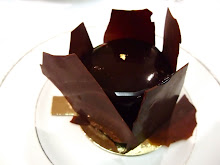I first learnt about umami during my gap year spent in Japan where umami was discovered in 1908 by Japanese scientist Kikunae Ikeda. Perhaps not surprisingly, umami is commonly known amongst the Japanese and without getting too nerdy, three key substances are now understood to comprise this 'delicious' taste: glutamate, inosinate and guanylate. Different foods have varying degrees of these three substances, and according to last year's Dashi and Umami,they act synergistically, thus augmenting the depth of flavour in foods we eat and giving that moreish taste
As a food anthropologist and as a cook with an experimental streak umami is endlessly fascinating to me. I consider it the universal super taste that amplifies even the most humble dishes to something memorable and have been known to bore friends and loved ones to tears with my nerdy enthusiasm for umami. One French friend refuses to accept umami even exists, but that could be because he is French
Pairing umami-rich foods is a brilliant way to create tasty dishes - fermented, dried and cured foods are especially rich in umami hence Japanese, and Asian cuisines are known to be umami-rich. But as you will see there are plenty of familiar European ingredients, sauces and condiments that give an extra bit of umami flair to your cooking. Think marmite, worcester sauce and ketchup to name but a few storecupboard staples. Needless to say, Scandinavian food is replete with umami - that's why we love our pickled herring, smoked salmon and fermented food in general
Here's a few examples of 旨味 umami hall-of-famers:
* Kombu has the highest natural level of glutamate of any foodstuff, followed closely more familiar ingredients such as:
* Parmesan Cheese (and other mature cheeses such as cheddar, blue cheese, etc)
* Ketchup (tomatoes, and especially the seeds are very high in umami)
* Marmite, Vegemite, Bovril
* Anchovies
* Nam Pla (Thai Fish sauce) and all fermented fish sauces for that matter
* Soy sauce
* Mirin
* Miso
* Chicken bouillon
* Dried mushrooms such as shiitake, porcini and morel
* Cured meat such as chorizo, pepperoni, proscuitto
* Cured fish such as smoked salmon
* Sauerkraut
* Human breast milk (oh yes, squirm away)
Fresh meat, fish, fruit and vegetables also contain umami, but the key with fruit and veg is how ripe they are. The riper the tomato the higher the umami content. This is why 'Italian' food is so delicious (excuse the generalisation, I appreciate there's a lot of regionality to Italian food) -in the south they grow plump tomatoes and eat them or cook these when they're at their ripest, and cook with umami staples such such as anchovies, parmesan, capers and mushrooms
Cheese is another umami bomb - as a general rule of thumb, the more fragrant (read pongy) the cheese, the more explosive the umami. Try experimenting with these ingredients to see if the overall flavour of a dish is boosted. A mushroom risotto will be irresistible even to most committed carnivore if you use loads of parmesan or other mature cheese, and if you're generous with the dried mushrooms like porcini, all the better
So when MsMarmitelover, or doyenne of the Underground Restaurant asked me to sous chef for her on an umami-themed night recently I relished the chance to experiment with different ingredients. You can read about umami night itself on her blog but suffice to say it was great fun working on the menu together and the guests loved what we concocted for them
It seems this dish I came up with was the guests' favourite - MsMarmitelover and I both concur, we considered this our best dish of the night:
Yuzu and shiro miso sea bass ceviche with pickled ginger

Serves 30 as a canape
4 large skinned sea bass fillets
1 cup ponzu sauce (yuzu-infused soy sauce)
1/2 cup tbsp shiro miso paste (white miso)
juice of 8 limes
juice and zest of 1 kaffir lime
handful of chopped umeboshi plums
red pickled ginger julienned for garnish
Method:
Mix the ponzu, miso paste and juice of the limes in a medium bowl. Add the kaffir lime zest and juice. Slice the sea bassinto bite-sized slivers and place in the marinade. Cover and refrigerate for 30 minutes and serve with pickled ginger and julienned shiso leaves if you have some
Easy-peasy, and that's umami's magic ;-)
We served it with Akashi Tai sake courtesy of the lovely Wakana































7 comments:
Really interesting stuff. Loving it. Is umami synonomous with 'salty' or can the two be teased apart? Just looking down that list it seems many of the items on it could also be considered salty
I apologise for the French person who dared told you that umami didn't exist! Knowing the popularity of ketchup in France, some french people should believe in it!
Thanks @Just Cook It, umami isn't necessarily salty per se but there's definitely a savoury element to it. Vintage champagne is thought to be umami, so sour things can be umami too, like sauerkraut...I like to think chocolate has LOADS of umami ;-)
@mathildecuisine LOL...no need to apologise, my friend the Frenchman is an insufferable snob. There are certainly lots of lovely umami-believing French people out there, like yourself!
That list (aside from breast milk) reads like 'My Favourite Things'.
I guess that's why the Chinese are so big on MSG, which was made to recreate that umami flavour.
This is interesting! Love your blog!
If Fuduyasan could see you now. :-)
ぽぽちゃん... ぽぽちゃん... ねこ げない ね!
Really enjoyed this post. Looking forward to trying that ceviche.
Post a Comment